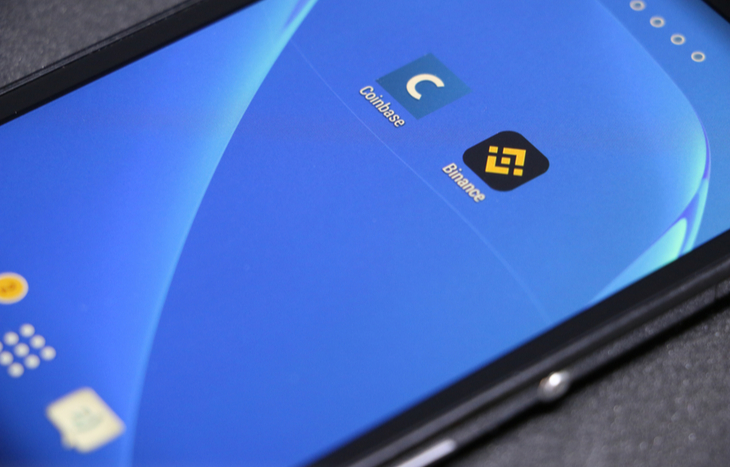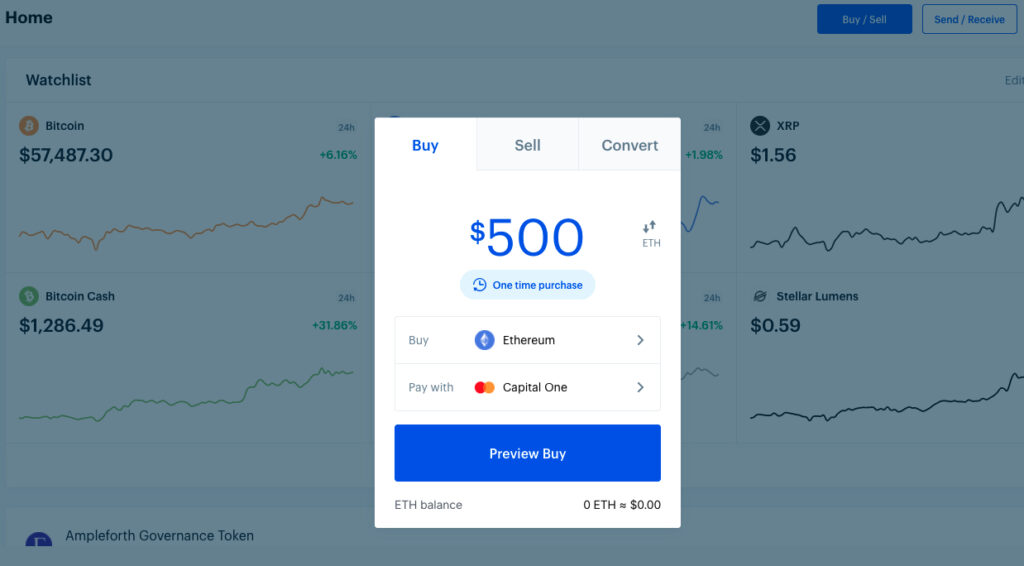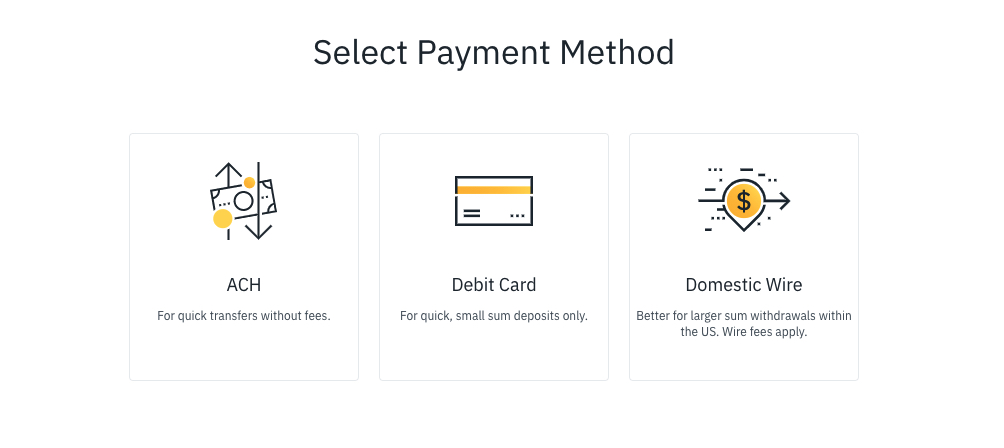Binance vs. Coinbase: Which Crypto Exchange Should You Use?
Binance vs. Coinbase? Which one’s best suited for your needs? It’s a trickier question than you might think. Both have their pros and cons. What it really boils down to is how you plan to invest in cryptocurrencies.

Binance and Coinbase are the two biggest crypto exchanges out there based on volume. So, between the two, most investors can find what they’re looking for in one of the two. But even still, these exchanges don’t have all the answers for all investors. Traders looking for small cap coins, coins with lower trading volume or new cryptos on the market will probably have to look elsewhere. But we’ll get into more details on that below.
Let’s start with the most basic aspect of the two exchanges…
Binance vs. Coinbase: the Interface
Coinbase’s home screen is clean and straightforward. Upon logging in, you can see your balance. And if you scroll down, you can check out the cryptos on your watch list. And a little below that, your portfolio is displayed. Super straightforward there.
The Binance home screen is a little busier. But with the extra clutter, you get more information. This one also starts by showing the details of your balance. There is an announcements box right next to it that shows the latest updates to your account. Below that is information regarding logins. This is a nice touch for those with security in mind. Being able to see whether your account has been logged into from other locations can be useful. Below those boxes is information about any open orders you may have and your personal trading level.
Based on its homepage alone, Coinbase looks a little slicker. But Binance offers more info right off the bat. Here it boils down to personal preference. In the battle between Binance vs. Coinbase, here’s the deal… If you like big icons and simplicity like an Apple computer, Coinbase wins this round. If you miss the joys of the Windows XP experience and prefer substance over style, Binance is for you.
Buying Crypto: Which Is Easier?
Now onto the important part. There’s a certain level of mysticism that seems to shroud the buying of crypto. But the duel between Binance vs. Coinbase shows that the mystery and difficulty can be erased.
Coinbase makes it about as simple as it can be to buy crypto. All you need to do is attach a credit or debit card to your account and start buying. Here’s what it looks like buying $500 worth of Ethereum:

It’s hard to imagine it getting much easier than this. The lone downfall is that new users have a $750 buying limit per day. For those who would prefer to not use a credit card, there are plenty of other options as well. You can also attach your bank account right to your Coinbase account to buy crypto, deposit cash and process buy orders instantly. Another option is to use a wire transfer to transfer cash into or out of a Coinbase account. These latter two options circumnavigate the $750 daily limit.
When it comes to transferring funds to your account, it’s a bit more difficult with Binance. So it’s naturally a bit more difficult to buy crypto there.
You can wire money directly to your account by filling out a form. But keep in mind there is a $15 transaction fee that comes with this. The other option for adding funds to your account is to attach a debit card (this comes with a 4.5% transfer fee). Or you can attach a bank account.

Binance uses the service Plaid to connect, encrypt and protect personal financial data when you connect a bank account. It’s very secure. And it’s also the cheapest route.
But there have been some hiccups in the actual process. In my personal experience, it’s taken several attempts over the course of a couple days to successfully connect my Binance and bank accounts. But once funds are secured in the account, buying crypto here is just as easy as on Coinbase.
Exchange Limitations
When it comes to the battle of Binance vs. Coinbase, it is like the New York Stock Exchange and Nasdaq. They’re both solid places to get started trading crypto. And they’ll both have many of the cryptos you might want to invest in. But they may not have them all…
Depending on where you live, Coinbase offers access to around 60 cryptocurrencies. You can easily find the regular suspects like Bitcoin, Ethereum and, of course, the head-scratchingly popular Dogecoin. But Binance offers access to more than 500 different cryptocurrencies. So for the little bit of extra effort it takes to start trading on Binance, you do get extra access. But – and this is a big BUT – this is the case only for those living outside of the U.S. The U.S. version has far fewer offerings. And there are several states that don’t allow access to Binance. Of course, there are ways to circumnavigate these issues using a VPN. But in an effort to keep the the government off our backs, we won’t go down that rabbit hole.
With more than 4,500 cryptos in circulation worldwide, neither Binance nor Coinbase offer comprehensive access. But what that means is investors using these exchanges are somewhat less likely to get sucked into a pump-and-dump scheme. To get listed on either exchange requires a submitted proposal and thorough vetting.
On that note, one of the upsides to Binance is that it has its own token. Those who start by buying Binance Coin (BNB) receive a discount when trading it for other cryptos. On top of this, BNB is a popular crypto to use on other, much smaller exchanges. You can use BNB to exchange for cryptos and NFTs on PancakeSwap and BakerySwap. This can give Binance a leg up on the competition for those who want access to initial coin offerings. But this is by no means the goal for all crypto investors.
Binance vs. Coinbase: the Bottom Line
On a personal note, I use and will continue to use both. Both are solid options to start trading cryptocurrencies. But when it comes down to Binance vs. Coinbase, the result really depends on what you plan on investing in and how active you’ll be.
If you’re just getting started in the world of crypto, Coinbase is a solid place to start. You can sign up for an account right here and be trading in no time. It’s like riding a bike with training wheels. Binance, on the other hand, takes a little more getting used to. The learning curve is slightly steeper. But it does offers more advanced charting tools. That can be a big boon for advanced traders.
Another plus for Coinbase is that it offers a hot storage wallet to keep your crypto secure. Those who use Binance should look into a third-party crypto wallet to keep their crypto secure safe.
The big feather in Binance’s cap is it has some of the lowest trading fees out there. Coinbase has some of the highest. So, if you’re going to be very active in your account and routinely deposi funds and make transactions, Binance is your best bet. But for set-it-and-forget-it investors, the fee structure on Coinbase won’t be as cumbersome.
Now, if you’re ready to start trading crypto but aren’t sure which coins you should be looking at, we suggest signing up for Manward Financial Digest. By doing so, you’ll get expert advice from crypto expert Andy Snyder as he covers the whole world of investing – not just crypto. And for what it’s worth, almost every crypto he hones in on can be found on Coinbase.
About Matthew Makowski
Matthew Makowski is a senior research analyst and writer at Investment U. He has been studying and writing about the markets for 20 years. Equally comfortable identifying value stocks as he is discounts in the crypto markets, Matthew began mining Bitcoin in 2011 and has since honed his focus on the cryptocurrency markets as a whole. He is a graduate of Rutgers University and lives in Colorado with his dogs Dorito and Pretzel.





